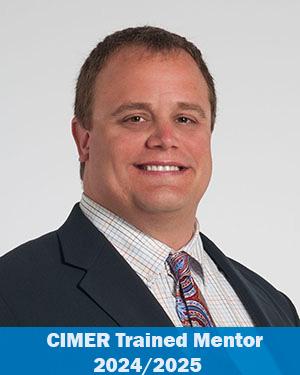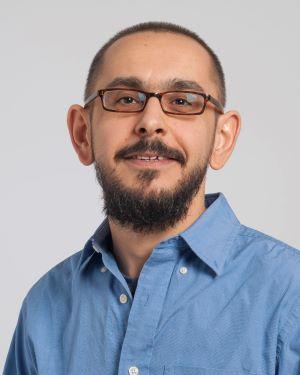Research News
09/30/2024
Researchers design new quantum error correction strategies
Cleveland Clinic investigators explore error correction methods for quantum computing results, building the infrastructure to address biomedical research questions.

One of the last steps in achieving quantum computing’s potential is developing quantum error correction methods. Researchers in Cleveland Clinic’s Center for Computational Life Sciences (CCLS) are taking on the challenge of creating new methods to ensure accurate results from quantum computations.
Part of adopting any advanced technology is designing the best practices for use. Cleveland Clinic’s Discovery Accelerator is supporting several projects that will increase our understanding of how to most effectively use quantum computing in healthcare and life sciences research. Ahmet Erdemir, PhD, CCLS Associate Staff, says when it comes to quantum computing, we are still in the critical beginning stages of applying quantum computing to research problems.
“Think about flight,” says Dr. Erdemir. “Today, we can fly around the world without a second thought, but it all started with the Wright Brothers figuring out the logistics. Right now, quantum computing is at the same stage as the Wright Brothers – we are just starting to understand its great potential.”
What is error correction?
Error correction is the ability to use software to identify and correct errors in its computations. Classical computers -- the computers we use every day -- have been capable of this for decades. Computer scientists developed optimization techniques to make sure that as classical computers advance, they are still able to produce accurate results.
Why don’t quantum computers have error correction?
Classical computing uses bits, a series of 1s and 0s, to solve problems. You can think of bits as being a yes or no, true or false, on or off. They can be either be one or the other. When classical computers solve problems, they use bits to identify the most probable results.
Quantum computers rely on qubits to give them their immense computational power. Qubits are units of information that use the properties of quantum mechanics to enhance computation. Qubits can exist in multiple states at once, so they are not limited by 1s and 0’s, they can also see all the possibilities between 1 and 0. This allows quantum computers to see significantly more possible outcomes – making them ideal for solving complex problems.
However, qubits are incredibly sensitive. Something as small as a sound wave or a change in temperature can cause errors in their performance. Though researchers are working hard to learn how they behave and how we can ensure accurate results, we still need to develop hardware and software that can overcome the instability of qubits to achieve error correction.
What error correction strategies are Cleveland Clinic researchers pursuing?
While quantum error correction is still being developed, CCLS researchers are developing methods to verify the accuracy of quantum computer’s results.
CCLS’ Daniel Blankenberg, PhD, CCLS Assistant Staff, and Bryan Raubenolt, PhD, a postdoctoral fellow, are working on a hybrid model that applies a mix of quantum and classical computing methods to ensure accuracy. The team starts their process by identifying small-scale problems that are either inaccurately or slowly solved with classical computing methods. The team then begins implementing quantum computing techniques to see if they can solve the problem faster or more accurately.
This approach to helping with errors and efficiency is called a “warm start” or “jump start”. A given quantum algorithm is first simulated on a classical computer, assuming an ideal, noiseless state. This simulation provides a set of optimized parameters in the quantum circuit. The algorithm is then run on a quantum computer with this optimized circuit, giving the quantum computer a head start in narrowing down the results to the most accurate ones. This approach helps reduce the length of time needed to use the quantum computer, which in itself helps alleviate the impact of error and noise.
In collaboration with IBM, Drs. Blankenberg and Raubenolt are creating a framework to accurately predict the structure of proteins by treating it as an optimization problem for the quantum computer to solve. The initial results outperformed both a classical physics-based method and AlphaFold2.
“We start with small-scale problems because we can run them on quantum computers without being limited by their current capabilities,” says Dr. Blankenberg. “Once we’ve developed the right quantum algorithms and approaches, we can start to increase their scale to solve larger, more complex problems.”
A team led by Kenneth Merz, PhD, is taking another approach: implementing error correction using a classical computer after running the initial calculations on a quantum computer.
“This is a departure from the way we are used to thinking,” says Dr. Merz, who is staff in CCLS. “Optimization usually focuses on eliminating errors from the process, whereas the sampling method still allows errors to occur. However, we benefit from being able to use the full power of the quantum computer.”
This method starts by using the quantum computer to provide sample results – typically 100,000-200,000 samples. These samples can then be checked on a classical computer by using simple metrics to determine if they are correct. If they are incorrect, they can then be iteratively corrected on classical hardware yielding the final error free and accurate result.
The Merz lab is using this method to study the properties and conformational space of molecules, which is critical for the drug discovery process. Researchers using traditional methods are limited to less accurate solutions due to the computational scaling of the problem. However, by using quantum computers to run the analysis, researchers will not be limited in their exploration of molecules' potential to fight disease and sustain health.
Featured Experts
News Category
Related News
Research areas
Want To Support Ground-Breaking Research at Cleveland Clinic?
Discover how you can help Cleveland Clinic save lives and continue to lead the transformation of healthcare.
Give to Cleveland Clinic

